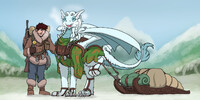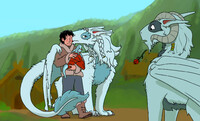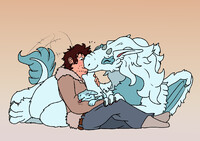
Somewhere along the northeastern coast of the lost continent lies a peaceful ocean inlet, walled by towering cliff-faced mountains on each side and covered by a carpet of lush evergreens. Known to the natives as the Crystal Delta, itself named for its beautifully clear, calm waters, well removed from the turbulence of the Greater Temporal. It is fed by the similarly named Crystal River, its cleanliness thanks to the mountain snowmelt that is its source and the naked bedrock it flows upon.
Within this inlet, beached at its innermost point, lies the wreck of the HRS Margarette, the first human vessel in history to survive a trans-Temporal voyage.
Well. Depending on your definition of "survive".
The Margarette is an older hull, laid down some 20 years earlier as a tramp steamer originally named the FTC Ogre, on commission to a private trade company. Somewhat larger than most freighters common to the Empire's home islands, it was an ambitious project meant to capitalize on a lucrative trade surge occurring at the time, with oversized boilers and screws meant to minimize length of voyage and maximize profits. These simple attributes made it an ideal candidate for the Research Commission's plans. The Grand Commissioner is something of a man of passions, you see, and sending mankind to the lost continent was a persistent dream of his. Convincing the King to allocate funds for even a single ship was something of a challenge, he so told us, but it was enough to purchase everything we could need.
And the ship needed quite a lot. Steel hulled though she was, the Greater Temporal was a span of ocean that one did not trifle with. Endless storms originating from great turning eyes that no one could hope to approach, mana-fed from a source no one could get close enough to discover. It left open water at a near-perpetual maelstrom that annihilated anything that sailed near. The outer reaches of nearly all of Eos were battered with hurricanes sent from the great eyes of the Temporal on a regular basis. Most sailors were deathly superstitious of the ocean and often refused to take their vessels beyond the sight of land. And so to have any chance of survival, the Margarette was thus drydocked and extensively reinforced. Extra ribs, a triple keel, watertight partitioning, anything to compartmentalize and stabilize the vessel against the worst conditions that could be assumed. Crew decks fully watertight up to a depth of 10 meters, able to remain afloat with up to half of it's hull compartments flooded, a hull over five inches thick in some places, and even able to self-right in the event of a total capsize! The scholar had to admit he found the long list of modifications quite heartening, perhaps that's how the Commission was able to persuade enough men to form an expedition at all! An empire-wide call to adventure and fortune returned a crew of 190 hardened sailors, widowed soldiers, adrenaline-chasing chancers, and a random array of the societal fringe and downtrodden. All were publicly promised a king's ransom should the expedition return home with any degree of success.
Well, as comprehensively overkill as her refit seemed, she ended up needing it. The navigator had selected for the crew a circuitous northern route, hoping to skirt the worst of the storms known to exist at the equator, and by all indications they HAD. The ocean beat the snot out of them regardless. Twenty three days of tossing, heaving, listening to the hull groan and shriek as they climbed mountainous swells and plunged into abyssal troughs, every so often punctuated by the terrible BANG of a rivet bursting free from a nearby bulkhead or the retch of a crewman voiding their stomach. Over the first week, twenty of the crew had been injured in falls as the vessel rocked, two killed. Week two, three men crushed by cargo snapping free of its lashings in the hold, fifteen more injured by falls. One man drowned in the bilge attempting to repair the bailing pumps. He succeeded. Week three, the ship was successfully capsized by a rogue wave. Seven dead, fifty five injured. Boiler two suffered a catastrophic failure upon full inversion as the funnel submerged and water entered the combustion chamber. Only an emergency vent saved the first from irreparable damage. The ship limped at an eighth-power for hours until the engine could regain full pressure.
By the time land was sighted, the Margarette was a limping hulk. She sat low, dangerously low, pumps barely able to keep afloat a hull riddled with cracks and fractures. Nonetheless, with nearly half the crew nursing injuries ranging from bruises to concussions and broken bones, and over a dozen dead, terra firma was a triumphant sight. Tall, ranging mountains met the ocean, rocky islands and inlets visible up and down the coast. One was picked at random. The ship's boiler surged as she made one final push, aiming for a gentle, rocky beach at the inlet's innermost point. With a great groan and a lurch, her bow left the water, digging a trench deep into the gravelstone. As she slid dozens of meters up onto the coast, a thunderous BOOM resonated through the entire ship as her back broke. Looking upon her from the shore, she sagged visibly, a dying beast that had breathed her last. They were stranded, unquestionably; even if she were back in drydock, the shipmasters would consider her good for nothing but scrap iron.
So for better or worse, Lasdock, literally "last dock", was founded. Her crew would use her broken hull as shelter for weeks as trees were cut and a modest tract of land was claimed. Soon enough, buildings sprung up around her. First driven stakes and then an entire palisade would be erected around the colony following encounters with less-than-friendly wildlife and some... unkind assumptions made of the eventually discovered natives. After some time, even a rudimentary tavern, bathhouse, and enough housing for most of the crew were constructed. Despite their best effort to create a tiny island of human comforts and civilization among the unknown, the colony's mood was one of lingering melancholy. No one knew if rescue would come. The Research Commission sending a second ship might well hinge entirely on their successful return, otherwise assuming a total loss. Even thinking long term, their population was mostly young and in fairly good overall health, but it was also 95% male. After a time most were able to resign themselves to their fate; after all, the Commission did not lie (much) about what they were signing up for. Many did not have immediate family, those that did grieved privately, or not at all. The few men of exceptionally poor emotional state were simply confined to the ship's brig until they calmed themselves down.
And so the most excitement, for a long time, came from the natives. While the scholar had met Aufei many weeks before the wider colony became aware of another intelligent species, the first meeting of the two peoples was on poor terms. The scholar blamed himself for that whole fiasco. He was arrogant back then, and though they had suffered together on the voyage he had often harboured lowly thoughts of the men that he cohabitated with. He had trusted only himself with knowledge of Aufei's existence and when she eventually told her own people of the Human's presence, the watchman was caught very much off guard by the appearance of a dozen woolcoats at the treeline. A pre-emptive shot fired from the palisades that gravely wounded one of their number gave a very bad first impression. The man had assumed they were animals, and the Scholar could not entirely blame him. He was only thankful his aim was just short of lethal.
It would be a long while before relations could be considered 'positive', but Lasdock would be known to persist through many a hardship, and remained steadfast to those it would eventually consider friends. A stubborn little fort if ever there was one, and thought it took some time it was a place the scholar was always happy to return.
Within this inlet, beached at its innermost point, lies the wreck of the HRS Margarette, the first human vessel in history to survive a trans-Temporal voyage.
Well. Depending on your definition of "survive".
The Margarette is an older hull, laid down some 20 years earlier as a tramp steamer originally named the FTC Ogre, on commission to a private trade company. Somewhat larger than most freighters common to the Empire's home islands, it was an ambitious project meant to capitalize on a lucrative trade surge occurring at the time, with oversized boilers and screws meant to minimize length of voyage and maximize profits. These simple attributes made it an ideal candidate for the Research Commission's plans. The Grand Commissioner is something of a man of passions, you see, and sending mankind to the lost continent was a persistent dream of his. Convincing the King to allocate funds for even a single ship was something of a challenge, he so told us, but it was enough to purchase everything we could need.
And the ship needed quite a lot. Steel hulled though she was, the Greater Temporal was a span of ocean that one did not trifle with. Endless storms originating from great turning eyes that no one could hope to approach, mana-fed from a source no one could get close enough to discover. It left open water at a near-perpetual maelstrom that annihilated anything that sailed near. The outer reaches of nearly all of Eos were battered with hurricanes sent from the great eyes of the Temporal on a regular basis. Most sailors were deathly superstitious of the ocean and often refused to take their vessels beyond the sight of land. And so to have any chance of survival, the Margarette was thus drydocked and extensively reinforced. Extra ribs, a triple keel, watertight partitioning, anything to compartmentalize and stabilize the vessel against the worst conditions that could be assumed. Crew decks fully watertight up to a depth of 10 meters, able to remain afloat with up to half of it's hull compartments flooded, a hull over five inches thick in some places, and even able to self-right in the event of a total capsize! The scholar had to admit he found the long list of modifications quite heartening, perhaps that's how the Commission was able to persuade enough men to form an expedition at all! An empire-wide call to adventure and fortune returned a crew of 190 hardened sailors, widowed soldiers, adrenaline-chasing chancers, and a random array of the societal fringe and downtrodden. All were publicly promised a king's ransom should the expedition return home with any degree of success.
Well, as comprehensively overkill as her refit seemed, she ended up needing it. The navigator had selected for the crew a circuitous northern route, hoping to skirt the worst of the storms known to exist at the equator, and by all indications they HAD. The ocean beat the snot out of them regardless. Twenty three days of tossing, heaving, listening to the hull groan and shriek as they climbed mountainous swells and plunged into abyssal troughs, every so often punctuated by the terrible BANG of a rivet bursting free from a nearby bulkhead or the retch of a crewman voiding their stomach. Over the first week, twenty of the crew had been injured in falls as the vessel rocked, two killed. Week two, three men crushed by cargo snapping free of its lashings in the hold, fifteen more injured by falls. One man drowned in the bilge attempting to repair the bailing pumps. He succeeded. Week three, the ship was successfully capsized by a rogue wave. Seven dead, fifty five injured. Boiler two suffered a catastrophic failure upon full inversion as the funnel submerged and water entered the combustion chamber. Only an emergency vent saved the first from irreparable damage. The ship limped at an eighth-power for hours until the engine could regain full pressure.
By the time land was sighted, the Margarette was a limping hulk. She sat low, dangerously low, pumps barely able to keep afloat a hull riddled with cracks and fractures. Nonetheless, with nearly half the crew nursing injuries ranging from bruises to concussions and broken bones, and over a dozen dead, terra firma was a triumphant sight. Tall, ranging mountains met the ocean, rocky islands and inlets visible up and down the coast. One was picked at random. The ship's boiler surged as she made one final push, aiming for a gentle, rocky beach at the inlet's innermost point. With a great groan and a lurch, her bow left the water, digging a trench deep into the gravelstone. As she slid dozens of meters up onto the coast, a thunderous BOOM resonated through the entire ship as her back broke. Looking upon her from the shore, she sagged visibly, a dying beast that had breathed her last. They were stranded, unquestionably; even if she were back in drydock, the shipmasters would consider her good for nothing but scrap iron.
So for better or worse, Lasdock, literally "last dock", was founded. Her crew would use her broken hull as shelter for weeks as trees were cut and a modest tract of land was claimed. Soon enough, buildings sprung up around her. First driven stakes and then an entire palisade would be erected around the colony following encounters with less-than-friendly wildlife and some... unkind assumptions made of the eventually discovered natives. After some time, even a rudimentary tavern, bathhouse, and enough housing for most of the crew were constructed. Despite their best effort to create a tiny island of human comforts and civilization among the unknown, the colony's mood was one of lingering melancholy. No one knew if rescue would come. The Research Commission sending a second ship might well hinge entirely on their successful return, otherwise assuming a total loss. Even thinking long term, their population was mostly young and in fairly good overall health, but it was also 95% male. After a time most were able to resign themselves to their fate; after all, the Commission did not lie (much) about what they were signing up for. Many did not have immediate family, those that did grieved privately, or not at all. The few men of exceptionally poor emotional state were simply confined to the ship's brig until they calmed themselves down.
And so the most excitement, for a long time, came from the natives. While the scholar had met Aufei many weeks before the wider colony became aware of another intelligent species, the first meeting of the two peoples was on poor terms. The scholar blamed himself for that whole fiasco. He was arrogant back then, and though they had suffered together on the voyage he had often harboured lowly thoughts of the men that he cohabitated with. He had trusted only himself with knowledge of Aufei's existence and when she eventually told her own people of the Human's presence, the watchman was caught very much off guard by the appearance of a dozen woolcoats at the treeline. A pre-emptive shot fired from the palisades that gravely wounded one of their number gave a very bad first impression. The man had assumed they were animals, and the Scholar could not entirely blame him. He was only thankful his aim was just short of lethal.
It would be a long while before relations could be considered 'positive', but Lasdock would be known to persist through many a hardship, and remained steadfast to those it would eventually consider friends. A stubborn little fort if ever there was one, and thought it took some time it was a place the scholar was always happy to return.
Category Artwork (Digital) / All
Species Unspecified / Any
Size 1300 x 810px
File Size 307.8 kB

 FA+
FA+








Comments